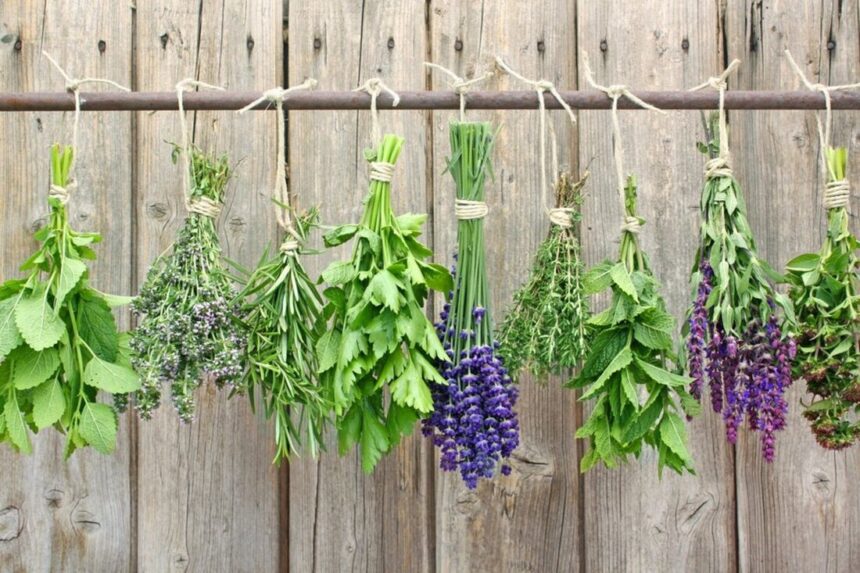Drying herbs and spices is an excellent way to preserve their flavor, aroma, and nutritional value for long periods. Whether you’re growing your own herbs or purchasing them in bulk, knowing the best drying techniques can make all the difference in the quality of the final product. In this guide, we’ll explore the most effective methods for drying herbs and spices, ensuring they maintain their potency and freshness.
1. Air Drying
Air drying is one of the oldest and most natural methods for drying herbs and spices. This technique involves hanging the herbs or spices in a well-ventilated area and allowing them to dry over time.
How to Air Dry Herbs and Spices:
- Choose a location with low humidity and good airflow, such as a dry, warm room or a shaded outdoor area.
- Tie herbs into small bundles using twine or string. Hang the bundles upside down to ensure the moisture is drawn out from the stems and leaves.
- Ensure adequate spacing between the bundles to promote airflow and prevent mold growth.
- Drying time can range from several days to two weeks, depending on the herb and the environment.
Air drying works best for herbs with low moisture content, such as rosemary, thyme, and oregano. However, it’s important to avoid direct sunlight, as it can cause the herbs to lose color and flavor.
2. Dehydrator Drying
A food dehydrator is an efficient and reliable way to dry herbs and spices quickly while preserving their taste and aroma. This method is particularly useful when drying large quantities of herbs.
How to Dry Herbs and Spices with a Dehydrator:
- Prepare herbs by washing them thoroughly and patting them dry with a towel.
- Arrange herbs on the dehydrator trays, ensuring they are spread out in a single layer.
- Set the dehydrator to a low temperature, typically between 35°C to 45°C (95°F to 115°F), which is ideal for drying herbs without damaging their essential oils.
- Drying time varies depending on the herb, but most herbs will be ready in 4 to 6 hours.
Dehydrators offer precise temperature control, making them an ideal option for drying delicate herbs like basil, mint, and parsley without overheating them.
3. Oven Drying
For those who need to dry herbs and spices quickly but don’t have a dehydrator, the oven can be a good alternative. However, this method requires careful temperature control to prevent over-drying or burning the herbs.
How to Dry Herbs and Spices in the Oven:
- Preheat the oven to the lowest setting, typically around 50°C to 60°C (120°F to 140°F). A lower temperature ensures that the herbs dry slowly without losing flavor.
- Place herbs on a baking sheet in a single layer. You can use parchment paper to prevent sticking.
- Leave the oven door slightly ajar to allow moisture to escape and promote airflow.
- Check regularly, and after about 1 to 2 hours, the herbs should be dry. The time can vary depending on the herb and the oven.
This method is quick, but it’s crucial to monitor the herbs closely to avoid burning them.
4. Microwave Drying
Microwave drying is one of the fastest methods, but it requires careful attention to avoid overheating the herbs. This technique is ideal for small batches of herbs that need to be dried quickly.
How to Dry Herbs and Spices in the Microwave:
- Place herbs between two paper towels or parchment paper.
- Set the microwave to a low or defrost setting. Heat the herbs in 30-second intervals, checking the progress after each interval.
- Continue microwaving until the herbs are dry and brittle. This process typically takes about 1 to 2 minutes, depending on the herb.
While microwave drying is fast, it can cause the herbs to lose some of their aroma and essential oils if overdone.
5. Sun Drying
Sun drying is an ancient method of preserving herbs and spices, perfect for hot, dry climates. However, it is not suitable for all herbs, as the direct sunlight can cause the loss of some volatile oils.
How to Dry Herbs and Spices in the Sun:
- Lay herbs on a flat surface, such as a clean cloth or mesh screen, in a sunny location.
- Cover the herbs with a fine mesh screen or cheesecloth to protect them from insects and debris.
- Turn the herbs regularly to ensure even drying.
- Drying time can vary, but it usually takes about 2 to 3 days, depending on the herb and the weather.
While this method is energy-efficient and natural, it’s important to monitor the herbs for any signs of mold or pests. Sun drying works best for heat-tolerant herbs like thyme, rosemary, and sage.
6. Freeze Drying
Freeze drying is a more advanced technique often used in commercial operations. This method preserves the herbs’ full flavor and nutrients by freezing them and then removing the moisture through sublimation.
How to Freeze Dry Herbs and Spices:
- Freeze herbs on a baking sheet until solid.
- Use a freeze-dryer to remove the moisture. The process involves placing the frozen herbs in a vacuum chamber and using low heat to extract water vapor without turning it into liquid form.
Freeze drying is an expensive and time-consuming process but is highly effective for preserving the herbs’ original flavor, color, and nutritional content.
7. Choosing the Right Method for Different Herbs and Spices
Not all herbs and spices respond the same to drying methods. Here are some guidelines:
- Hard, woody herbs like rosemary, thyme, and oregano do well with air drying, dehydrators, or oven drying.
- Tender herbs such as basil, parsley, and cilantro are best dried in a dehydrator or with the microwave method to retain their delicate flavors.
- Spices like chili peppers or garlic can be air-dried or dehydrated, depending on the moisture content.
The best drying technique for herbs and spices depends on your available equipment, the quantity of herbs, and the desired flavor retention. While air drying is a natural, low-maintenance method, a food dehydrator or freeze drying offers faster, more consistent results. Regardless of the method you choose, proper drying ensures that your herbs and spices remain flavorful and aromatic long after harvest.
By mastering these drying techniques, you can enjoy homegrown herbs and spices year-round, whether for culinary use, medicinal purposes, or even as beautiful homegrown gifts.







